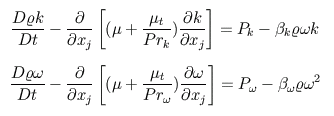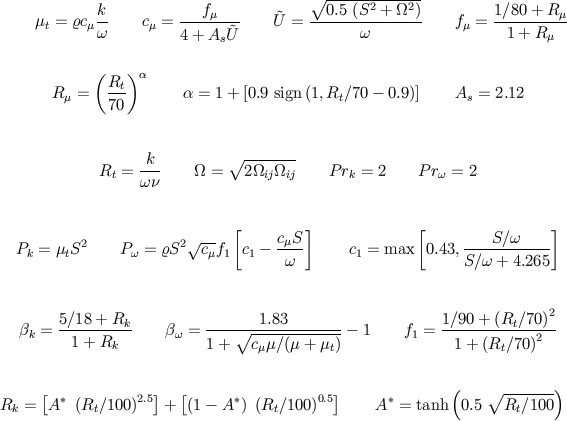
|
The Linear Local Realizable Turbulence Model (LLR)
T. Rung
|
|
- Introduction
The accurate prediction of complex, non-equilibrium
shear flows which are close to
separation whilst developing on a continuous surface is important in many
fluids engineering devices operating at high-load conditions where maximum
performance (e.g. pressure recovery) is obtained. In such circumstances,
separation may either be provoked or suppressed in response to even slight
variations in the computational representation. Hence, the predictive quality of
the flow's gross characteristics may hinge on seemingly subtle modelling details
in apparently innocuous flow portions. The objective of the presented LLR
 model contributes to better capabilities
in predicting such flows.
The nature and rationale of the model are briefly outlined and results
are reported in comparison to other modelling strategies.
model contributes to better capabilities
in predicting such flows.
The nature and rationale of the model are briefly outlined and results
are reported in comparison to other modelling strategies.
- Low-Re formulation
Among the most pressing needs in the area of engineering turbulence modelling
is the development of a low-Re number
formulation, which facilitates a reliable description of the turbulence
processes across the entire domain, including the semi-viscous
near-wall regime, without the input of any ``non-local'' information,
such as wall-topography parameters.
Generally,
the simultaneous presence of shear and severe adverse pressure gradient
in the near-wall region leads to a complex, highly anisotropic turbulence
structure, where the
assumption that all turbulence quantities scale with the friction velocity
fails, because the near-wall flow is no longer universally controlled by the
wall shear-stress.
- Length-scale equation
Although a general approach would, arguably, be based on full second-moment
closure, which might even include a tensorial representation of dissipation, a
simpler, computationally cheaper approach involving scalar turbulence
quantities
is defensible, provided this approach returns the correct boundary-layer
structure, in particular with respect to the development of turbulent shear,
and its response to adverse pressure gradient.
The knowledge that the  -equation is a
major contributor to the
misrepresentation of turbulence transport in adverse pressure gradient flows has
motivated the adoption of a modified -equation is a
major contributor to the
misrepresentation of turbulence transport in adverse pressure gradient flows has
motivated the adoption of a modified  variant throughout the present effort. Further motivation results from the
experience that the
variant throughout the present effort. Further motivation results from the
experience that the  frame is
numerically forgiving in terms of near-wall resolution and stiffness and does
not necessarily require non-local informations. frame is
numerically forgiving in terms of near-wall resolution and stiffness and does
not necessarily require non-local informations.
- Modelling equations
The present formulation is to a large extend in line with Shih's
[3]
high-Re  approach which is based on
modelling the dynamic equation for approach which is based on
modelling the dynamic equation for  rather than
rather than  .
The model consists of the following governing equations: .
The model consists of the following governing equations:


The applied low-Re number damping functions have been sensitised to the
turbulence Reynolds number so as to achieve the desired asymptotic near-wall
behaviour of k, and to conform with DNS data.
- Realizability
In order to secure realizability, the coefficient
 must not be a constant, and must
be related to mean strain and, arguably, vorticity rate
[4].
This rationale is certainly also at the root of Menter's
[5] shear-stress
limiting ``SST'' modification of the must not be a constant, and must
be related to mean strain and, arguably, vorticity rate
[4].
This rationale is certainly also at the root of Menter's
[5] shear-stress
limiting ``SST'' modification of the  model which has become increasingly popular during the last decade.
However, in contrast to this, Shih's proposal, which has slightly been
changed in the present formulation, applies a more sophisticated approach
which tries to accomplish consistent stress-strain
distributions not only in 2D plane shear flow, but also
more general flow situations. Furthermore, the consideration of strain rate
invariants within the Shih formulation has advantages not only with regard
to realizability, but also regimes of irrotational strain,
where most models tend to overestimate the turbulence production.
In the following, attention is drawn to the predictive capabilities of the
present LLR
model which has become increasingly popular during the last decade.
However, in contrast to this, Shih's proposal, which has slightly been
changed in the present formulation, applies a more sophisticated approach
which tries to accomplish consistent stress-strain
distributions not only in 2D plane shear flow, but also
more general flow situations. Furthermore, the consideration of strain rate
invariants within the Shih formulation has advantages not only with regard
to realizability, but also regimes of irrotational strain,
where most models tend to overestimate the turbulence production.
In the following, attention is drawn to the predictive capabilities of the
present LLR  model in comparison to
three other low-Re eddy-viscosity models:
a model in comparison to
three other low-Re eddy-viscosity models:
a  model with improved predictive
accuracy in adverse pressure gradient flows reported by Lien & Leschziner
[6], the standard model with improved predictive
accuracy in adverse pressure gradient flows reported by Lien & Leschziner
[6], the standard
 model
of Wilcox [7] and
Menters SST model
of Wilcox [7] and
Menters SST  model.
More detailled information on the model and its rationale can be found
in [1] [2]. model.
More detailled information on the model and its rationale can be found
in [1] [2].
- References
- Rung, T. and Thiele, F. "Computational modelling of complex boundary-layer flows. "Proc. 9th Intern. Symposium on Transport Phenomena in Thermal-Fluid Engineering, Singapore, pp. 321-326, 1996.
- Rung, T. "Realizability linearer Stress-Strain Beziehungen. "Institutsbericht 04/98, Hermann-Föttinger Institut, TU Berlin, 1998.
- Shih, T.H., Liou, W.W., Shabbir, A., Yang, Z. and Zhu, J. "A new eddy viscosity model for high reynolds number turbulent flows." Computers & Fluids, Vol. 24, No. 3, pp. 227-238, 1995.
- Shih, T.H., Zhu, J. and Lumley, J. "A realizable algebraic stress model." Symp. on Turbulent Shear Flow, Kyoto (Japan), Paper 3.5, 1993.
- Menter, F. "Zonal Two Equation Model for Aerodynamic Flows." AIAA Paper 93-2906, 1993.
- Lien, F.S. and Leschziner, M.A. "Computational modelling of 3D turbulent flow in S-diffusor and transient ducts." Engineering Turbulence Modelling and Experiments Elsevier, Amsterdam, pp. 217-228, 1993.
- Wilcox, D.C. "Reassesment of the scale determing equation for advanced turbulence models." AIAA Journal Vol. 26, No. 11,pp. 1299-1310, 1988.
| 

